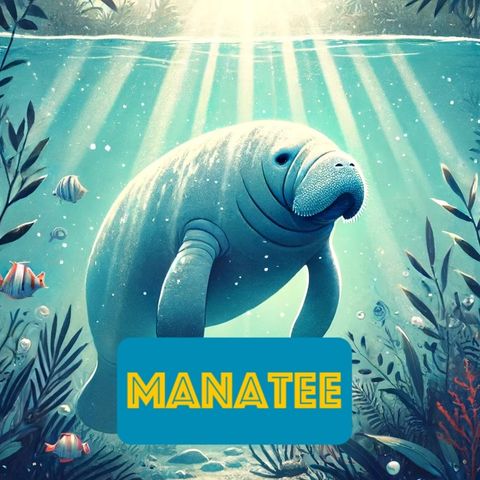Manatees Serene Gentle Giants of the Coastal Waters

Download and listen anywhere
Download your favorite episodes and enjoy them, wherever you are! Sign up or log in now to access offline listening.
Description
The Serene Gentle Giants of the Coastal Waters As the first golden rays of dawn peeked over the horizon, their warm glow danced across the calm, clear waters of the...
show moreAs the first golden rays of dawn peeked over the horizon, their warm glow danced across the calm, clear waters of the Caribbean coast. This was the ideal morning for the region's most placid and endearing marine mammals to languidly emerge and greet the new day.
A large, rounded snout broke through the surface, followed by a whiskered, almost smiling face taking its first deep breath of the dawn's fresh air. This was a West Indian manatee, one of the sea's most peaceable and charming giants. Its small, squinting eyes slowly blinked away the lingering grogginess from a night spent sedentarily resting on the shallow bottom.
Manatees are mighty yet exceptionally docile creatures, the last surviving representatives of an ancient aquatic species that grazed the earth over 60 million years ago alongside prehistoric mammals like woolly mammoths and saber-toothed tigers. These modern-day "sea cows" are true ambassadors of the tropical marine world, embodying a gentle, unbothered nature that exemplifies the carefree coastal lifestyle.
As more of its cumbersome 10-foot long, thousand-pound body emerged, the manatee's distinctive barrel-shaped figure and powerful, horizontally-flattened paddle-like tail were revealed. Its tough but flexible aquatic hide was a mottled greyish-brown, calloused and scarred with scratches and spots earned through a life spent arduously grazing and migrating across the shallow rivers, bays, estuaries and coastal waters of the Caribbean.
Surfacing for its first morning meal, the manatee raised its large whiskered snout and began grazing on the leafy aquatic vegetation lining the bottom. These gentle behemoths possess a voracious appetite, consuming up to an astonishing 10-15% of their body weight daily in greens, which can amount to over 150 pounds. Their sustenance routine is frequently interrupted as they must periodically surface for air, with their large lung capacity allowing them to remain submerged for up to 20 minutes before requiring another breath.
As the late morning warmth set in, the lone manatee was joined by several more of its kind engaged in the same languid routine of eating, resting and refilling their life-sustaining air supply. Despite their massive size and relative lack of natural predators, these sluggish marine relatives of the elephant are social creatures at heart. They frequently travel in groups or "herds" ranging from just a few individuals to nearly twenty, engaging in communication through a series of audible chirps, squeaks and barks.
Mother manatees are particularly nurturing and protective, nursing their single offspring for up to two years and leading them along their migratory routes until the calves are able to survive independently. A calf's safety is the prime concern, with the mother using her huge, half-ton bulk to shield her young from any potential threats, including aggressive male manatees and, most perilously, humankind.
Despite being powerful enough to survive in the rough open ocean, manatees are particularly vulnerable to human activities and environmental changes, which have caused their wild populations to shrink dramatically from untold millions to just a few thousand over the past few centuries. These distinctive "sea cows" now only migrate along the waters of the Southeastern United States, Central America and throughout the broader Caribbean.
Their rapidly dwindling numbers can be attributed to several factors stemming from human interference, most notably hunting, habitat loss from residential and industrial development, and injuries from boat propellers. Their skittish yet gentle demeanor often puts them in harm's way, as they tend to flee only at the last moment from these disruptive human activities.
In response, the manatee has become a celebrated focus of conservation efforts worldwide, with organizations striving to enforce protective laws, rehabilitate injured individuals, and educate the public on peacefully coexisting with these endearing sea giants. The beloved Miami Seaquarium has long been a leading institution in manatee rehabilitation and reintroduction to the wild. Across Florida, many communities have designated certain waterways as manatee sanctuaries, enforcing strict no-entry zones and reduced speed limits in areas the mammals are known to frequent.
Through these noble undertakings, there is hope that future generations of humans and manatees can continue to encounter each other, with people admiring the ancient ocean ambassadors making their unhurried way through tropical waters. Perhaps one day, the manatee's migratory paths and coastal resting grounds will be fully protected, allowing their populations to safely rebound to the plentiful numbers that once enriched the azure environments they have called home for over 60 million years.
As the fiery sun began dipping below the horizon, painting the sky in brilliant oranges and reds, the herd of manatees slowly regrouped and prepared their evening migration toward their resting grounds for the night. They would travel single-file, the hulking adults surrounding the young calves, placidly leading their perpetual pursuit of safe harbors offering abundant vegetation and shelter.
Information
| Author | QP-4 |
| Organization | William Corbin |
| Website | - |
| Tags |
Copyright 2024 - Spreaker Inc. an iHeartMedia Company

Comments